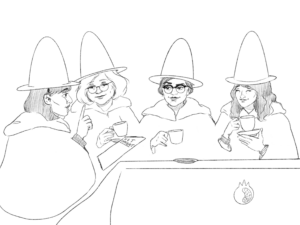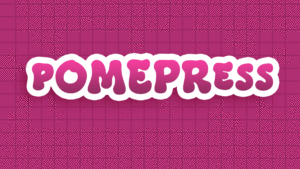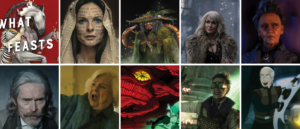We at POME are always looking to support unique voices in the comics-creation world, and today is no different. Our last installment of “Throw Money at this Kickstarter” brought you a thoughtful, beautiful comics anthology full of North American legends and lore, and today we’re here to talk about another wonderful new comic book: Fantasy Quest by Jess Smart Smiley.
Jess Smart Smiley was gracious enough to offer us a little of his time for a Q&A about his upcoming book, and about the comics creation process in general!
The Kickstarter for Fantasy Quest can be found ~~~here~~~ (good news for you enamel pin fans!) and Jess’s other books (many of which we discuss in this Q&A) can all be purchased through his website!
Jenny Mott (POME): You’ve been pretty active in the young reader’s comics/illustration world for a while now, but for those in our audience who may be unfamiliar with your work, go ahead and introduce yourself!
Jess Smart Smiley: Hi! My name is Jess Smart Smiley and I make rad pictures with my bare hands. My first all-ages graphic novel, Upside Down: A Vampire Tale, is a funny fairy tale of sorts published by Top Shelf. Since Upside Down, I have written and/or illustrated 14 other books and comics for young readers. I regularly visit schools and libraries (in person and via Skype), and I teach writing, drawing, and comics workshops.
POME: The story of Fantasy Quest follows Sofi, a little redheaded girl, who is met by a magical frog and introduced to a world of fantastic secrets and adorable dangers. Elements of magic and fantasy are common in many of your works, and that’s something that we at POME can certainly understand. But, what draws you to that genre?
JSS: What a wonderful question! One reason I love fantasy so much is that there’s no artifice inherent to the genre. We pick up a fantasy knowing that the story is made-up, and that the “rules” of magic are going to be different in each book we pick up. I like making up “rules” about worlds and magic systems and characters, without being tied to any specific preconceived notions. I also like that a fantasy story can be largely free from any kind of allusions to our reality, or even to other stories or characters within the genre.
POME: Absolutely! How do you strike a balance between fantasy, which as you say “can be largely free from any kind of allusions to our reality,” and relatable human emotion and relationships, especially familial relationships, which are so prevalent in the Upside Down books, as well as, to some extent, in Fantasy Quest?
JSS: Ray Bradbury was great at taking the most disparate, fantastic characters and plots, and sticking them together with humanity. Upside Down and Fantasy Quest are both fantasy, but are rooted in the characters’ desire for a sense of belonging and purpose. That humanity is a great way for us mere mortals to relate to cartoon vampires and magical frogs.
POME: I am personally a long-time fan of the Upside Down graphic novels, but your new book, Fantasy Quest, does something different. Fantasy Quest is an interactive comic that uses maze games to move the story forward.
What inspired you to combine more traditional narrative comics with an activity book puzzle game? And why mazes, specifically?
JSS: Thanks! I read this wonderful zine by Wai Wai Pang and Ed Cheverton called Maze Quest (does that name sound familiar?), and I was taken back to my fifth-grade self, when I would make mazes on graph paper with my friends and pass comics to each other in class. I wanted to capture that same excitement and wonder of my fifth-grade self, and the bombastic characters and stories we came up with back in the day. Part of what made our comics so fun came from the fact that we were passing our comics to each other, adding a panel, and then passing it to on someone else. Fantasy Quest includes mazes that allow the reader to move the story forward by helping Sofi catch up with the frog, and helping characters run away from threats that come from within the book. I thought it would be a fun way to make the story a sort of game that the reader and I could play together.
POME: On the comic-creation side of things, your art is really jam-packed and dynamic. Especially in Fantasy Quest, some of the panels will be sideways or upside-down, encouraging the reader to engage with the book in a really physical way. That can naturally be seen as an extension of the larger goal to “make the story a sort of game that the reader and [you] could play together.” I found that panelling decision to be really fun and also thoughtful.
In your experience, how do those kinds of ideas come to you? or rather, what does your creative process look like — does it all come out when you’re drawing or does inspiration more often strike when you least expect it? Is it some combination?
JSS: Another wonderful question! It sounds silly, but I had to give myself permission to have fun with Fantasy Quest. Once I was able to let go of the idea that “I’m making a book” and the pressure that “people might actually end up seeing this”, I was able to turn the book into a sort of experiment in storytelling, and I was able to come up with ideas that worked well for this story, but maybe don’t belong in other things I’m working on.
Most of the ideas for characters, plot points, and explorations in form came from drawing and writing in my sketchbook without trying to force the story one way or another. I love learning about story structure and character development, but I decided to let the Fantasy Quest characters speak for themselves and determine the story. It was really fun getting to know Sofi and Thomas McMagic and the other characters by drawing them over and over again in different ways, until I finally understood how they were supposed to look and talk and think.
I should also mention that the bulk of the pages were improvised. Once I had drawn a character enough to have a good “feel” for their nature, I would draw a square page in my sketchbook and put the character in motion. As with most of my sketchbook drawings, I drew directly in ink. Working this way forces me to either own my mistakes and make them part of the comic, or to simply move on, leave the mistake behind, and start over. In some ways, creating the pages was sort of like adding to a Rube Goldberg machine, one piece at a time, and then watching all the parts interact with each other and keep the momentum of the story in play.
POME: That improvisation sounds a lot like the way you talked about building comics with your friends in elementary school! Collaborative storytelling is just so cool (especially in comics)! I know you worked with Dave Scheidt in the creation of Spooky Sleepover, and certainly most illustration work for books by other authors would be a collaborative process.
What do you like best about working with other creators as opposed to working on books that you both write and illustrate yourself? What are some of the challenges?
JSS: Yeah! Spooky Sleepover features 3 goofy horror comics written by Dave Scheidt. It came out of our mutual love for monsters and Halloween, and it allowed me to play with different drawing styles and techniques. Dave is a blast to work with and I’m hoping we will make many more books together.
With Spooky Sleepover, Dave would message me some basic ideas for stories, and we’d focus on the ones we were most excited about. Dave is pretty quick about working up scripts, so he would type up the action and dialogue, breaking the story up into pages and panel, then send it all to me. Dave is great about offering me creative freedom, so if I see something he’s written as a single panel and I envision it working better as two panels, then he’s totally fine with me doing that. He’s one of the few writers I’ve met that really seems to understand that words and pictures work together to tell a story, and that an illustrator shouldn’t simply draw only what is written. He’s great at picking out different artists for different projects, knowing not only which artist would have the best voice for each project, but also which artist would bring the best process to the project.
I haven’t been involved in too many comics collaborations, but I do like working with a team and bouncing ideas off of each other. At its worst, a collaboration can become a clash of personalities and vision, but I think it’s worth the risk, as a solid collaboration results in something much more than either creator could accomplish on their own. I feel like that’s what happened in working with Dave on Spooky Sleepover, and it’s carried over into other comics we have made for Adventure Time #45 and Wrapped Up #1.
Making a book on my own is a pretty different process, since I’m responsible for the story, text, and all artwork. Plus, I usually change the process for each book, since each book has different needs and goals.
(This answer has been sponsored by Dave Scheidt ©®™.)
POME: Alright! Wrapping up! What comics are you reading right now? What are some of your all-time faves?
JSS: Oh, man–there are so many great comics in the world! I’m currently reading Tillie Walden’s Spinning, and I’m loving it. Her books A City Inside and The End of Summer are wonderful stories and I’ve been happy to share them with several friends over the last year.
Some of my all-time favorite comics include:
- Hellboy by Mike Mignola
- The Fantasy Sports books by Sam Bosma
- The Hilda books by Luke Pearson
- Isaac the Pirate by Christophe Blain
- The Unsinkable Walker Bean by Aaron Renier
- Building Stories and Quimby the Mouse by Chris Ware
- Maus by Art Spiegelman
- Smile by Raina Telgemeier
- Iron Westi by Doug TenNapel
- The Hazardous Tales books by Nathan Hale
(Note: the POME comics crones are also big fans of the Fantasy Sports books by Sam Bosma.)
POME: Thank you so much for sitting down with us! I’ve really enjoyed this chance to pick your brain a little bit, and to share the word of Fantasy Quest with our readers.
JSS: Great! Thanks so much for your willingness to spread the word about me and my comics, and thanks for your thought-provoking questions!
We at POME are big fans of paper games and activity books in general. So, we’re very excited about this book because it blends that love with our love of comics, and we hope we’ve convinced you to check it out! You can head on over to the Fantasy Quest Kickstarter page to pledge to this project and grab a copy, and you can go to Jess Smart Smiley’s website to check out his other books and projects!
Be sure to keep an eye out for his other 2018 release, Let’s Make Comics! An Activity Book to Create, Write, and Draw Your Own Cartoons, which is available now for preorder from Amazon, and will be released by Penguin Random House imprint Watson-Guptill on Tuesday, June 5.









